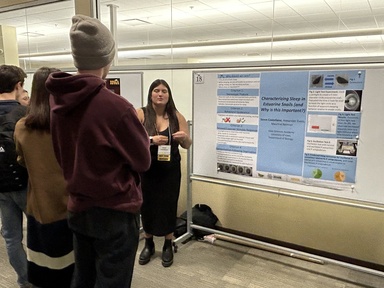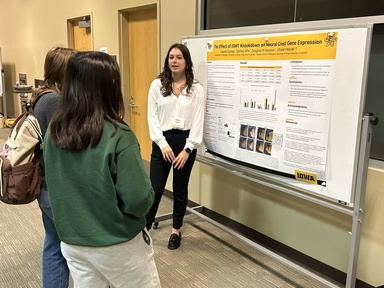Paid undergraduate research, coursework, having a mentor, career guidance, and being in a cohort of students with similar interests are some of the benefits the Science Alliance Internship (SAI) program offers underrepresented first- and second-year students. Hands-on paid research along with science outreach are two opportunities many SAI students find most valuable. Here's more about these opportunities and how the SAI students benefit from them.
Upon acceptance into the SAI program, a student is matched with a mentor. Through the mentor connection, students are given the opportunity to conduct hands-on research they can receive a competitive wage for. This research gives the students firsthand experience of the components, challenges, and wins that research can bring. The Spring 2024 semester involved 21 SAI students conducting research in 20 different labs on campus. Over 1,166 hours of research were logged. Let's hear from a couple of students about their spring research experience.

Science Alliance Intern Quinn Eldridge conducted research during the spring semester in Dr. Mary Weber's lab, which investigates the mechanisms by which the obligate intracellular pathogens Chlamydia trachomatis and Orientia tsutsugamushi co-opt a vast array of essential host cell processes to promote bacterial entry, survival, and replication. Quinn worked on two proteins, CebN and CteG, each having their own role in helping C.t. create its intracellular niche. When asked what he enjoyed most, Quinn said, "I really enjoy my research because it's a newer subfield of bacteriology. C.t. has previously been difficult to study because of its resistance to genetic modification, so there are still a lot of early discoveries to be made. It's exciting to be on the edge of what we know!" While enjoyable, Quinn further commented that "The most challenging aspect of conducting this research is that things can go wrong all the time! Biological systems are very complex and temperamental. You can run a procedure exactly the same three times and it might work once. It can be frustrating in the moment, but it's super satisfying when things work in the lab." Quinn is continuing with the Iowa Sciences Academy this summer and in the 2024-2025 Academic Year as a UI-MARC Fellow.

Krishna Bharadwaj conducted research in Dr. Chris Brochu's lab, which explores the phylogeny and historical biogeography of crocodyliforms -- alligators, crocodiles, gharials, and their close relatives. On his research experience, Krishna describes that "I did research through my freshman year with vertebrate paleontologist Chris Brochu. For my research, I constructed detailed scientific illustrations of a modern-day crocodile skull. Through these illustrations, we hope to further our understanding of how both modern-day and extinct crocodyliforms are related. I think that the most enjoyable part of this experience has been finally getting hands-on experience in the field of my interest. The most challenging thing I experienced was simply time management and having to balance school and research."
While not required, one of the science outreach experiences Science Alliance Interns can participate in is poster fairs. This past academic year, multiple SAI students presented posters at the Fall and Spring Undergraduate Research Fairs (FURF and SURF). These research festivals are held in celebration and recognition of undergraduate researchers' contributions to research, scholarly, and creative work at the University of Iowa. Read more about these research festivals here.
FURF 2023
Krishna Bharadwaj
Scientific illustration of a crocodylidae skull

Seren Castellano
Characterizing Sleep in Estuarine Snails

Quinn Eldridge
Characterization of Chlamydia trachomatis Type III Secreted Effector Protein CT584

Lauren Gomez
The Effect of ISM1 Knockdown on Neural Crest Gene Expression

Chidera Mitchell
Low sodium diet and aldosterone increases the activity of HSD2 neurons in mice

SURF 2024
Fabiola Castaneda-Santiago
Diversity of Eupelmids parasites of oak gall wasps
